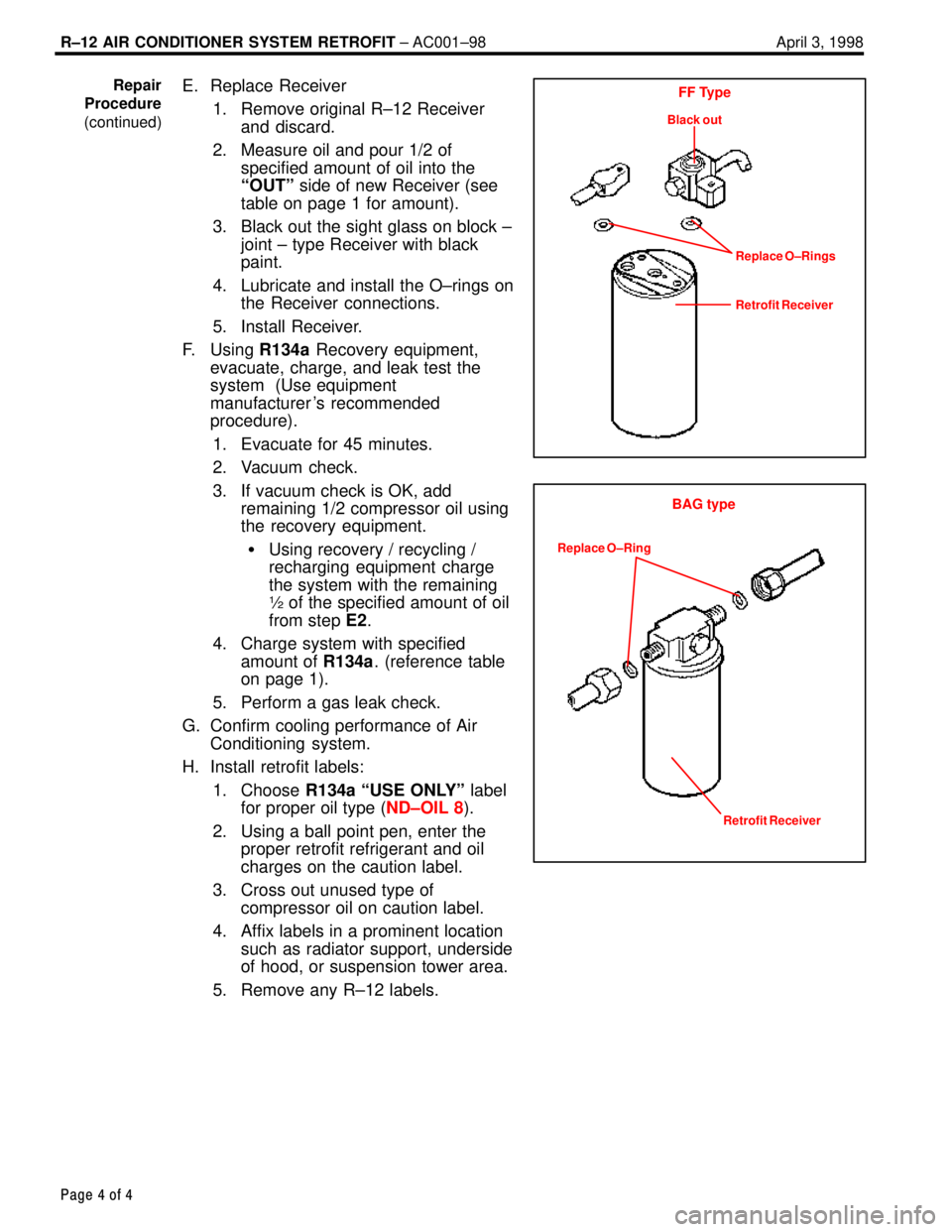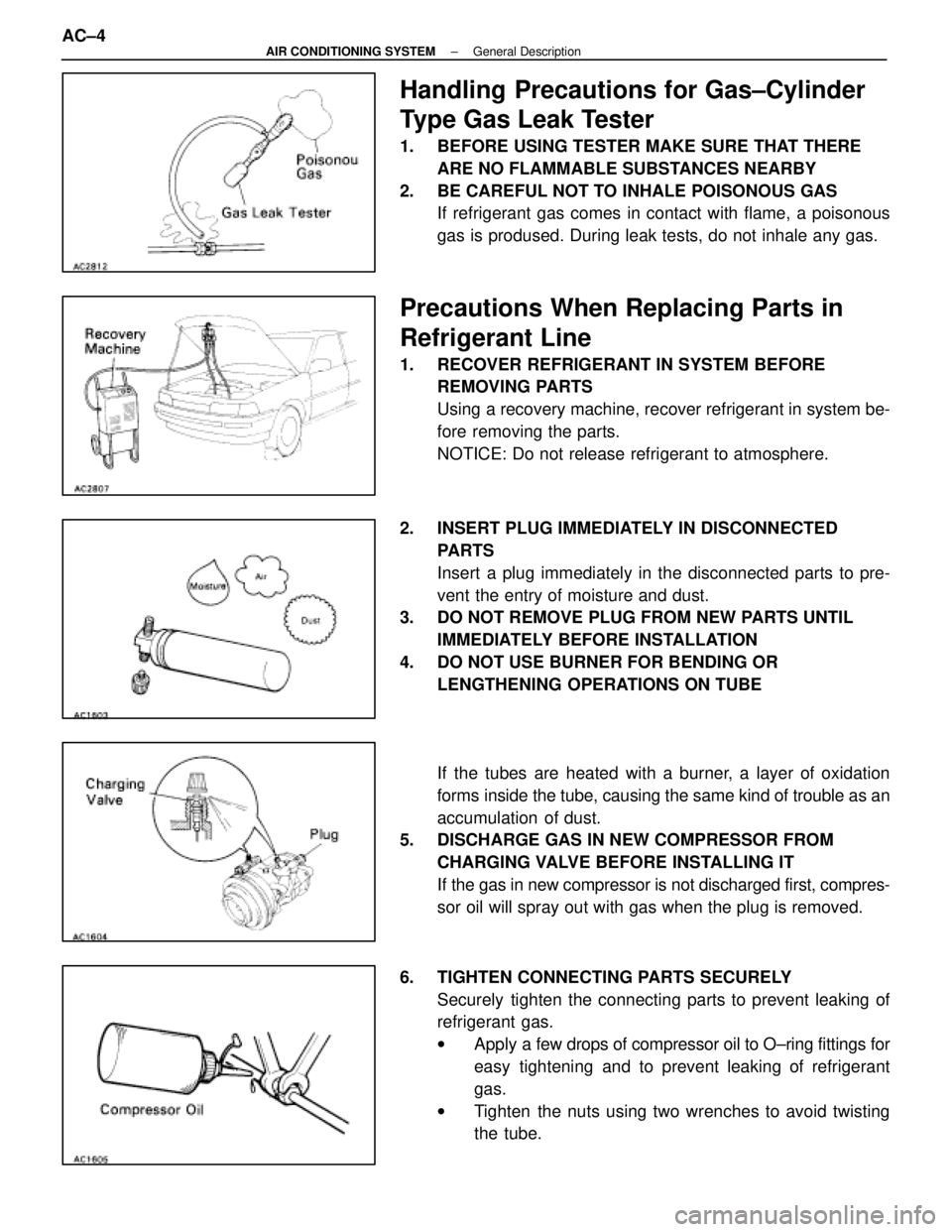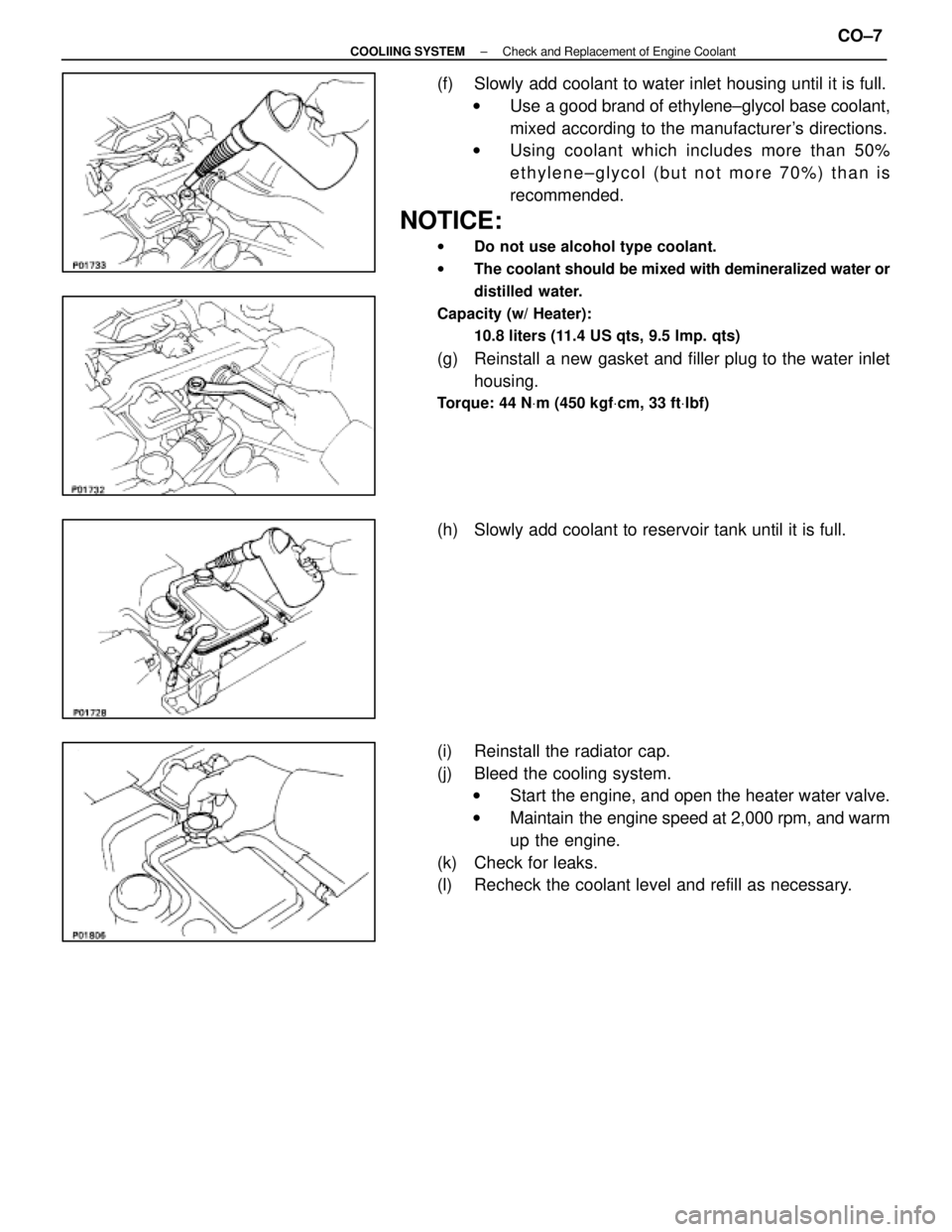1991 LEXUS SC400 gas type
[x] Cancel search: gas typePage 41 of 4087

R±12 AIR CONDITIONER SYSTEM RETROFIT ± AC001±98 April 3, 1998
Page 4 of 4
E. Replace Receiver
1. Remove original R±12 Receiverand discard.
2. Measure oil and pour 1/2 of specified amount of oil into the
ªOUTº side of new Receiver (see
table on page 1 for amount).
3. Black out the sight glass on block ± joint ± type Receiver with black
paint.
4. Lubricate and install the O±rings on the Receiver connections.
5. Install Receiver.
F. Using R134a Recovery equipment,
evacuate, charge, and leak test the
system (Use equipment
manufacturer 's recommended
procedure).
1. Evacuate for 45 minutes.
2. Vacuum check.
3. If vacuum check is OK, add remaining 1/2 compressor oil using
the recovery equipment.
� Using recovery / recycling /
recharging equipment charge
the system with the remaining
½ of the specified amount of oil
from step E2.
4. Charge system with specified amount of R134a. (reference table
on page 1).
5. Perform a gas leak check.
G. Confirm cooling performance of Air Conditioning system.
H. Install retrofit labels:
1. Choose R134a ªUSE ONLYº label
for proper oil type ( ND±OIL 8).
2. Using a ball point pen, enter the proper retrofit refrigerant and oil
charges on the caution label.
3. Cross out unused type of compressor oil on caution label.
4. Affix labels in a prominent location such as radiator support, underside
of hood, or suspension tower area.
5. Remove any R±12 labels.Repair
Procedure
(continued)FF Type
Black out
Replace O±Rings
Retrofit Receiver
BAG type
Replace O±Ring
Retrofit Receiver
WhereEverybodyKnowsYourName
Page 45 of 4087

Handling Precautions for Gas±Cylinder
Type Gas Leak Tester
1. BEFORE USING TESTER MAKE SURE THAT THEREARE NO FLAMMABLE SUBSTANCES NEARBY
2. BE CAREFUL NOT TO INHALE POISONOUS GAS If refrigerant gas comes in contact with flame, a poisonous
gas is prodused. During leak tests, do not inhale any gas.
Precautions When Replacing Parts in
Refrigerant Line
1. RECOVER REFRIGERANT IN SYSTEM BEFOREREMOVING PARTS
Using a recovery machine, recover refrigerant in system be-
fore removing the parts.
NOTICE: Do not release refrigerant to atmosphere.
2. INSERT PLUG IMMEDIATELY IN DISCONNECTED PARTS
Insert a plug immediately in the disconnected parts to pre-
vent the entry of moisture and dust.
3. DO NOT REMOVE PLUG FROM NEW PARTS UNTIL
IMMEDIATELY BEFORE INSTALLATION
4. DO NOT USE BURNER FOR BENDING OR LENGTHENING OPERATIONS ON TUBE
If the tubes are heated with a burner, a layer of oxidation
forms inside the tube, causing the same kind of trouble as an
accumulation of dust.
5. DISCHARGE GAS IN NEW COMPRESSOR FROM
CHARGING VALVE BEFORE INSTALLING IT
If the gas in new compressor is not discharged first, compres-
sor oil will spray out with gas when the plug is removed.
6. TIGHTEN CONNECTING PARTS SECURELY Securely tighten the connecting parts to prevent leaking of
refrigerant gas.
wApply a few drops of compressor oil to O±ring fittings for
easy tightening and to prevent leaking of refrigerant
gas.
w Tighten the nuts using two wrenches to avoid twisting
the tube.
AC±4
±
AIR CONDITIONING SYSTEM General Description
WhereEverybodyKnowsYourName
Page 219 of 4087

OPERATION
FUNCTION OF COMPONENTS
1. FRONT AIRBAG SENSORA front airbag sensor is mounted inside each of the front
fenders. The sensor unit is a mechanical type. When the sen-
sor detects deceleration force above a predetermined limit in
a collision, the contacts in the sensor make contact, sending
a signal to the center airbag sensor assembly. The sensor
cannot be disassembled.
2. SPIRAL CABLE (in COMBINATION SWITCH) A spiral cable is used as an electrical joint from the vehicle
body side to the steering wheel.
3. STEERING WHEEL PAD (with AIRBAG) The inflater and bag of the airbag system are stored in the
steering wheel pad and cannot be disassembled.
The inflater contains a squib, igniter charge, gas generant,
etc., and inflates the bag in case of a frontal collision.
4. AIRBAG WARNING LIGHT The airbag warning light is located on the combination meter.
It goes on to alert the driver of trouble in the system when a
malfunction is detected in the center airbag sensor assembly
self±diagnosis. In normal operating condition when the igni-
tion switch is turned to the ACC or ON position, the light goes
on for about 6 seconds and then goes off.
5. CENTER AIRBAG SENSOR ASSEMBLY The center airbag sensor assembly is mounted on the floor
inside the center cluster. The center airbag sensor assembly
consists of a center airbag sensor, safing sensors, ignition
control and drive circuit, diagnosis circuit, etc. It receives sig-
nals f rom the airbag sensors, judges whether the airbag must
be activated or not and diagnoses system malfunctions. AB±5
± OperationSRS AIRBAG
WhereEverybodyKnowsYourName
Page 1154 of 4087

CodeMaterial
name Heat *
resistant
temperature
limit
°C (°F) Resistance to
alcohol or gasoline Notes
AAS Acrylonitrile
Acrylic Styrene 80
(176) Alcohol is harmless if applied
only for short time in small
amounts (e.g., quick wiping to
remove grease). Avoid gasoline and or-
ganic or aromatic sol-
vents.
ABS Acrylonitrile
Butadiene Styrene 80
(176) Alcohol is harmless if applied
only for short time in small
amounts (e.g., quick wiping to
remove grease).
Avoid gasoline and or-
ganic or aromatic sol-
vents.
AES Acrylonitrile
Ethylene Styrene 80
(176) Alcohol is harmless if applied
only for short time in small
amounts (e.g., quick wiping to
remove grease). Avoid gasoline and or-
ganic or aromatic sol-
vents.
BMC Bulk
Moulding
Compound
150
(302) Alcohol and gasoline are
harmless. Most solvents are
harmless.
CAB Cellulose
Acetate 80
(176) Alcohol is harmless if applied
only for short time in small
amounts (e.g., quick wiping to
remove grease). Avoid gasoline and or-
ganic or aromatic sol-
vents.
EPDM Ethylene
Propylene 100
(212) Alcohol is harmless.
Gasoline is harmless if applied
only for short time in small
amounts. Most solvents are harm-
less but avoid dipping in
gasoline, solvents, etc.
PA Polyamide
(Nylon) 80
(176) Alcohol and gasoline are
harmless.
Avoid battery acid.
PBT Polybutylene
Terephthalate 160
(320) Alcohol and gasoline are
harmless. Most solvents are
harmless.
PC Polycarbonate 120
(248) Alcohol is harmless. Avoid gasoline, brake
fluid, wax, wax removers
and organic solvents.
PE Polyethylene 80
(176) Alcohol and gasoline are
harmless. Most solvents are
harmless.
PET Polyethylene
Terephthalate 75
(167) Alcohol and gasoline are
harmless.
Avoid dipping in water.
HANDLING PRECAUTIONS
1. The repair procedure for plastic body parts must conform with the type o\
f plastic material.
2. Plastic body parts are identified by the codes in the following chart.
3. When repairing metal body parts adjoining plastic body parts (by brazin\
g, frame cutting, welding, paint-
ing, etc.), consideration must given to the property of the plastic.
*Temperatures higher than those listed here may result in material deforma\
tion during repair.
PLASTIC BODY PARTSPP-2
WhereEverybodyKnowsYourName
Page 1266 of 4087

(f) Slowly add coolant to water inlet housing until it is full.w Use a good brand of ethylene±glycol base coolant,
mixed according to the manufacturer's directions.
w Using coolant which includes more than 50%
ethylene±glycol (but not more 70%) than is
recommended.
NOTICE:
w Do not use alcohol type coolant.
w The coolant should be mixed with demineralized water or
distilled water.
Capacity (w/ Heater): 10.8 liters (11.4 US qts, 9.5 lmp. qts)
(g) Reinstall a new gasket and filler plug to the water inlethousing.
Torque: 44 N Vm (450 kgf Vcm, 33 ft Vlbf)
(h) Slowly add coolant to reservoir tank until it is full.
(i) Reinstall the radiator cap.
(j) Bleed the cooling system.
w Start the engine, and open the heater water valve.
w Maintain the engine speed at 2,000 rpm, and warm
up the engine.
(k) Check for leaks.
(l) Recheck the coolant level and refill as necessary.
±
COOLIING SYSTEM Check and Replacement of Engine CoolantCO±7
WhereEverybodyKnowsYourName
Page 1380 of 4087

The 1 UZ±FE engine has 8±cylinders in a V±arrangement at a bank an\
gle of 905. From the front of the RH
bank cylinders are numbered 2 ± 4 ± 6 ± 8, and from the front of t\
he LH bank cylinders are 1 ± 3 ± 5 ± 7.
The crankshaft is supported by 5 bearings inside the crankcase. These beari\
ngs are made of a copper and
lead alloy.
The crankshaft is integrated with 8 weights for balance. Oil holes are plac\
ed in the center of the crankshaft
to supply oil to the connecting rods, bearing, pistons and other component\
s.
The ignition order is 1 ± 8 ± 4 ± 3 ± 6 ± 5 ± 7 ± 2. T\
he cylinder head is made of alminum alloy, with a cross
flow type intake and exhaust layout and with pent±roof type combustion chambers. The spark plugs are
located in the center of the combustion chambers.
At the front and rear of the intake manifold, a water passage has been p\
rovided which connects the RH
and LH cylinder heads.
Exhaust and intake valves are equipped with irregular pitch springs made\
of special valve spring carbon
steel which are capable of functioning at all engine speeds.
The RH and LH intake camshaft are driven by a timing belt, and a gear on\
the intake camshaft engages
with a gear on the exhaust camshaft to drive it. The cam journal is supp\
orted at 5 (intake) or 4 (exhaust)
places between the valve lifters of each cylinder and on the front end o\
f the cylinder head. Lubrication of
the cam journals and gears is accomplished by oil being supplied through th\
e oiler port in the center of the
camshaft.
Adjustment of the valve clearance is done by means of an outer shim type\
system, in which valve adjusting
shims are located above the valve lifters. This permits replacement of the sh\
ims without removal of the
camshafts.
Pistons are made of high temperature±resistant aluminum alloy, and a depression is built into the piston
head to prevent interference with the valves.
Piston pins are the full±floating type, with the pins fastened to neither the piston boss nor the connecting
rods. Instead, snap rings are fitted on both ends of the pins, preventing the\
pins from falling out.
The No.1 compression ring is made of steel and the No.2 compression ring\
is made of cast iron. The oil
ring is made of a combination of steel and stainless steel. The outer diamet\
er of each piston ring is slightly
larger than the diameter of the piston and the flexibility of the rings allows them to hug the cylinder walls
when they are mounted on the piston. Compression rings No.1 and No.2 work to\
prevent gas leakage from
the cylinder and the oil ring works to scrape oil off the cylinder walls to prevent it from entering the combus-
tion chambers.
The cylinder block is made of aluminum alloy with a bank of 90 5. Cast iron cylinders are installed inside
the cylinder block. It has 8 cylinders which are approximately twice the le\
ngth of the piston stroke. The top
of each cylinder is closed off by the cylinder head and the lower end of the cylinders becomes the crank-
case, in which the crankshaft is installed. In addition, the cylinder block c\
ontains a water jacket, through
which coolant is pumped to cool the cylinders.
The No.1 and No.2 oil pans are bolted onto the bottom of the cylinder bl\
ock. The No.1 oil pan is made of
aluminum alloy. The No.2 oil pan is an oil reservoir made of pressed steel sheet. An o\
il level sensor is
installed in the No.1 oil pan (If oil level drops below a set level, a warning light\
s up.). And oil pan baffle plate
keeps sufficient oil in the bottom of the No.2 oil pan even when the vehicle is t\
ilted. This dividing plate also
prevents the oil from marking waves when the vehicle is stopped suddenly\
and the oil shifts away from the
oil pump suction pipe.
Plastic region tighten bolts are used for the cylinder head, main bearin\
g cap and connecting rod.
EG±4
±
1UZ±FE ENGINE ENGINE MECHANICAL
WhereEverybodyKnowsYourName
Page 1647 of 4087

The 1 UZ±FE engine has 8±cylinders in a V±arrangement at a bank an\
gle of 905. From the front of the RH
bank cylinders are numbered 2±4±6±8, and from the front of the LH b\
ank cylinders are numbered 1 ±3±5±7.
The crankshaft is supported by 5 bearings specified by the inside of the cr\
ankcase. These bearings are made
of a copper and lead alloy. The crankshaft is integrated with 8 weights which are cast along with it\
for balancing. Oil holes are built
into the center of the crankshaft for supplying oil to the connecting ro\
ds, pistons and other components. The ignition order is 1±8±4±3±6±5±7±2. The cylinder\
head is made of aluminum alloy, with a cross flow
type intake and exhaust layout and with pent±roof type combustion chambers. The spark plugs are loca\
ted in
the center of the combustion chambers.
At the front and rear of the intake manifold, a water passage has been p\
rovided which connects the RH
and LH cylinder heads. Exhaust and intake valves are equipped with irregular pitch springs made\
of special valve spring carbon
steel which are capable of following no matter what the engine speed.
The RH and LH intake camshafts are driven by a single timing belt, and a ge\
ar on the intake camshaft en-
gages with a gear on the exhaust camshaft to drive it. The camshaft jour\
nal is supported at 5 (intake) or 4 (ex-
haust) places between the valve lifters of each cylinder and on the front end of the cylinder \
head. Lubrication
of the cam journal gear is accomplished by oil being supplied through the \
oiler port in the center of the camshaft. Adjustment of the valve clearance is done by means of an outer shim type\
system, in which valve adjusting
shims are located above the valve lifters. This permits replacement of the sh\
ims without removal of the cam-
shafts. Pistons are made of high temperature±resistant aluminum alloy, and a depression is built into the piston
head to prevent interference with valves.
Piston pins are the full±floating type, with the pins fastened to neither the piston boss nor the connecting
rods. Instead, snap rings are fitted on both ends of the pins, preventing the\
pins from falling out. The No.1 compression ring is made of steel and the No.2 compression ring\
is made of cast iron. The oil
ring is m ade of a combination of steel and stainless steel. The outer diameter of\
each piston ring is slightly larger
than the diameter of the piston and the flexibility of the rings allows them\
to hug the cylinder walls when they
are mounted on the piston. Compression rings No.1 and No.2 work to prevent \
the leakage of gas from the cylin-
der and the oil ring works to scrape oil off the cylinder walls to prevent it from entering the combustion chamber. The cylinder block is made of aluminum alloy with a bank angle of 90 5. Cast iron cylinders are installed
inside the cylinder block. It has 8 cylinders which are approximately twice the length of th\
e piston stroke. The
top of each cylinder is closed off by the cylinder heads and the lower end of the cylinders becomes the crank-
case, in which the crankshaft is installed. In addition, the cylinder bl\
ock contains a water jacket, through which
coolant is pumped to cool the cylinders. The No.1 and No.2 oil pans are bolted onto the bottom of the cylinder block\
. The No.1 oil pan is made of
aluminum alloy. The No.2 oil pan is an oil reservoir made of pressed steel sheet. An o\
il level sensor is installed
in the No.1 oil pan (If the oil level drops below a set level, a warnin\
g light lights up.). A oil pan baffle plate keeps
sufficient oil in the bottom of the No.2 oil pan even when the vehicle is tilted. \
This dividing plate also prevents
the oil from making waves when the vehicle is stopped suddenly and the oil \
shifts away from the oil pump suction
pipe. Plastic region tightening bolts are used for the cylinder head, main bearing ca\
p and connecting rod.
EM±4
±
ENGINE MECHANICAL Operation
WhereEverybodyKnowsYourName
Page 1999 of 4087

TORQUE SPECIFICATIONS
Part tightenedNVmkgf Vcmft Vlbf
Fuel line Union bolt type
Flare nut type2930022
Fuel pipe X Delivery pipe39400 29
Fuel pump bracket X Fuel tank5.455 48 in.Vlbf
Fuel pump set plate X Fuel tank3.940 35 in. Vlbf
Fuel tank X Body25250 18
Fuel sender gauge X Fuel tank2.930 26 in. Vlbf
Fuel inlet pipe X Fuel tank2.930 26 in. Vlbf
Fuel tank main tube X Fuel tank29300 22
Fuel tank return tube X Fuel tank29300 22
Fuel tank evaporation vent tube X Fuel tank29300 22
Air flow meter X Air cleaner case10100 7
Cold start injector X Air intake chamber7.880 69 in. Vlbf
Cold start injector tube X Cold start injector15150 11
Air intake chamber X Intake manifold18185 13
EGR pipe X Air intake chamber18185 13
EGR pipe X RH cylinder head18185 13
Cold start injector tube X RH Delivery pipe15150 11
Throttle body X Air intake chamber18185 13
Fuel return pipe X Fuel pressure regulator35360 26
Fuel pressure regulator X RH delivery pipe29300 22
Delivery pipe X Intake manifold18185 13
Fuel inlet hose X LH delivery pipe39400 29
for SST33340 24
ISC valve X Air intake chamber18185 13
Cold start injector time switch X Front water by±pass joint34350 25
Water temperature sensor X Front water by±pass joint20200 14
Water inlet housing X Water pump18185 13
EGR gas temperature sensor X EGR valve adaptor20200 14
EGR valve adaptor X Air intake chamber18185 13
EGR valve X EGR valve adaptor18185 13
Knock sensor X Cylinder block44450 33
Intake manifold X Cylinder head18185 13
Main oxygen sensor X Exhaust manifold44450 33
Sub±oxygen sensor X Exhaust manifold4445033
FI±142EFI SYSTEM ± Service Specifications
WhereEverybodyKnowsYourName